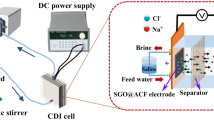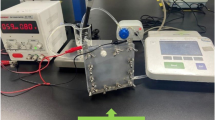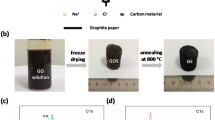Abstract
Carbonaceous materials, one of the most important electrode materials for sea water desalination, have attracted tremendous attention. Herein, we develop a facile and effective two-step strategy to fabricate hierarchical porous carbon nanotubes/graphene/carbon nanofibers (CNTs/G/CNFs) composites for capacitive desalination application. Graphite oxide (GO), Ni2+, and Co2+ are introduced into polyacrylonitrile (PAN) nanofibers by electrospinning method. During the annealing process, the PAN nanofibers are carbonized into CNFs felt, while the CNTs grow in situ on the surface of CNFs and graphite oxide are reduced into graphene simultaneously. Benefiting from the unique hierarchical porous structure, the as-prepared CNTs/G/CNFs composites have a large specific surface area of 223.9 m2 g−1 and excellent electrical conductivity. The maximum salt capacity of the composites can reach to 36.0 mg g−1, and the adsorbing capability maintains a large retention of 96.9% after five cycles. Moreover, the effective deionization time of the CNTs/G/CNFs composites lasts more than 30 min, much better than the commercial carbon fibers (C-CFs) and graphene/carbon nanofibers (G/CNFs) composites. Results suggest that the designed hierarchical porous CNTs/G/CNFs architecture could enhance the capacitive desalination properties of electrode materials. And the possible adsorption mechanism of the novel electrode materials is proposed as well.










Similar content being viewed by others
References
Porada S, Zhao R, Van Der Wal A, Presser V, Biesheuvel PM (2013) Review on the science and technology of water desalination by capacitive deionization. Prog Mater Sci 58:1388–1442
Xiang X, Zou S, He Z (2017) Energy consumption of water recovery from wastewater in a submerged forward osmosis system using commercial liquid fertilizer as a draw solute. Sep Purif Technol 174:432–438
Mohammadi T, Kaviani A (2003) Water shortage and seawater desalination by electrodialysis. Desalination 158:267–270
Al-Karaghouli A, Kazmerski LL (2013) Energy consumption and water production cost of conventional and renewable-energy-powered desalination processes. Renew Sust Energ Rev 24:343–356
Choi S-H (2016) On the brine re-utilization of a multi-stage flashing (MSF) desalination plant. Desalination 398:64–76
Zhang F, Xu S, Feng D, Chen S, Du R, Su C, Shen B (2017) A low-temperature multi-effect desalination system powered by the cooling water of a diesel engine. Desalination 404:112–120
Reddy KS, Sharon H (2016) Active multi-effect vertical solar still: mathematical modeling, performance investigation and enviro-economic analyses. Desalination 395:99–120
Han D, He WF, Yue C, Pu WH (2017) Study on desalination of zero-emission system based on mechanical vapor compression. Appl Energ 185:1490–1496
Swaminathan J, Nayar KG, Lienhard VJH (2016) Mechanical vapor compression-membrane distillation hybrids for reduced specific energy consumption. Desalin Water Treat 57:26507–26517
Fujiwara M (2017) Water desalination using visible light by disperse red 1 modified PTFE membrane. Desalination 404:79–86
Demir ME, Dincer I (2017) Development of an integrated hybrid solar thermal power system with thermoelectric generator for desalination 404 and power production. Desalination 404:59–71
Khamis I, El-Emam RS (2016) IAEA coordinated research activity on nuclear desalination: the quest for new technologies and techno-economic assessment. Desalination 394:56–63
Faibish RS, Konishi T (2003) Nuclear desalination: a viable option for producing freshwater. Desalination 157:241–252
Wang T, Yu S, L-a Hou (2017) Impacts of HPAM molecular weights on desalination performance of ion exchange membranes and fouling mechanism. Desalination 404:50–58
Venugopal K, Dharmalingam S (2016) Synthetic salt water desalination by electrodialysis using reinforced ion exchange membranes for acid–base production. Int J Plast Technol 20:315–333
Du Y, Liu Y, Zhang S, Xu Y (2016) Optimization of seawater reverse osmosis desalination networks with permeate split design considering boron removal. Ind Eng Chem Res 55:12860–12879
Imran B, Khan SJ, Qazi IA, Arshad M (2016) Removal and recovery of sodium hydroxide (NaOH) from industrial wastewater by two-stage diffusion dialysis (DD) and electrodialysis (ED) processes. Desalin Water Treat 57:7926–7932
Xie M, Gray SR (2016) Gypsum scaling in forward osmosis: role of membrane surface chemistry. J Membrane Sci 513:250–259
Anderson MA, Cudero AL, Palma J (2010) Capacitive deionization as an electrochemical means of saving energy and delivering clean water. Comparison to present desalination practices: will it compete? Electrochim Acta 55:3845–3856
Oren Y (2008) Review: capacitive deionization (CDI) for desalination and water treatment—past, present and future. Desalination 228:10–29
Lee J-H, Ahn H-J, Cho D, Youn J-I, Kim Y-J, Oh H-J (2015) Effect of surface modification of carbon felts on capacitive deionization for desalination. Carbon Lett 16:93–100
Chung S, Kang H, Ocon JD, Lee JK, Lee J (2015) Enhanced electrical and mass transfer characteristics of acid-treated carbon nanotubes for capacitive deionization. Curr Appl Phys 15:1539–1544
Kiyohara K, Shioyama H, Sugino T, Asaka K (2012) Phase transition in porous electrodes. II. Effect of asymmetry in the ion size. J Chem Phys 136:094701
Gao Y, Pan L, Li H, Zhang Y, Zhang Z, Chen Y, Sun Z (2009) Electrosorption behavior of cations with carbon nanotubes and carbon nanofibres composite film electrodes. Thin Solid Films 517:1616–1619
Rasines G, Lavela P, Macías C, Zafra MC, Tirado JL, Ania CO (2015) Mesoporous carbon black-aerogel composites with optimized properties for the electro-assisted removal of sodium chloride from brackish water. J Electroanal Chem 741:42–50
Ma C-Y, Huang S-C, Chou P-H, Den W, Hou C-H (2016) Application of a multiwalled carbon nanotube-chitosan composite as an electrode in the electrosorption process for water purification. Chemosphere 146:113–120
Wang G, Dong Q, Wu T, Zhan F, Zhou M, Qiu J (2016) Ultrasound-assisted preparation of electrospun carbon fiber/graphene electrodes for capacitive deionization: importance and unique role of electrical conductivity. Carbon 103:311–317
Tuan TN, Chung S, Lee JK, Lee J (2015) Improvement of water softening efficiency in capacitive deionization by ultra purification process of reduced graphene oxide. Curr Appl Phys 15:1397–1401
Tsai Y-C, R-A Doong (2016) Hierarchically ordered mesoporous carbons and silver nanoparticles as asymmetric electrodes for highly efficient capacitive deionization. Desalination 398:171–179
Oschatz M, Boukhalfa S, Nickel W, Hofmann JP, Fischer C, Yushin G, Kaskel S (2017) Carbide-derived carbon aerogels with tunable pore structure as versatile electrode material in high power supercapacitors. Carbon 113:283–291
Pan H, Yang J, Wang S, Xiong Z, Cai W, Liu J (2015) Facile fabrication of porous carbon nanofibers by electrospun PAN/dimethyl sulfone for capacitive deionization. J Mater Chem A 3:13827–13834
Im JS, Kim JG, Lee Y-S (2014) Effects of pore structure on the high-performance capacitive deionization using chemically activated carbon nanofibers. J Nanosci Nanotechno 14:2268–2273
Lee D, Choe J, Nam S, Lim JW, Choi I, Lee DG (2017) Development of non-woven carbon felt composite bipolar plates using the soft layer method. Compos Struct 160:976–982
Wang G, Pan C, Wang L, Dong Q, Yu C, Zhao Z, Qiu J (2012) Activated carbon nanofiber webs made by electrospinning for capacitive deionization. Electrochim Acta 69:65–70
Xu Y, Zondlo JW, Finklea HO, Brennsteiner A (2000) Electrosorption of uranium on carbon fibers as a means of environmental remediation. Fuel Process Technol 68:189–208
Li Y, Quan J, Branford-White C, Williams GR, Wu J-X, Zhu L-M (2012) Electrospun polyacrylonitrile-glycopolymer nanofibrous membranes for enzyme immobilization. J Mol Catal B-Enzym 76:15–22
Rao M, Geng X, Li X, Hu S, Li W (2012) Lithium-sulfur cell with combining carbon nanofibers–sulfur cathode and gel polymer electrolyte. J Power Sources 212:179–185
Nikolic-Jaric M, Romanuik SF, Ferrier GA, Bridges GE, Butler M, Sunley K, Thomson DJ, Freeman MR (2009) Microwave frequency sensor for detection of biological cells in microfluidic channels. Biomicrofluidics 3:034103
Wang H, Zhang Y, Shao H, Hu X (2005) Electrospun ultra-fine silk fibroin fibers from aqueous solutions. J Mater Sci 40:5359–5363. https://doi.org/10.1007/s10853-005-4332-2
Anis SF, Lalia BS, Mostafa AO, Hashaikeh R (2017) Electrospun nickel–tungsten oxide composite fibers as active electrocatalysts for hydrogen evolution reaction. J Mater Sci 52:7269–7281. https://doi.org/10.1007/s10853-017-0964-2
Guo Z, Huang J, Xue Z, Wang X (2016) Electrospun graphene oxide/carbon composite nanofibers with well-developed mesoporous structure and their adsorption performance for benzene and butanone. Chem Eng J 306:99–106
Jindal A, Gautam DK, Basu S (2016) Electrocatalytic activity of electrospun carbon nitride-polyacrylonitrile nanofiber towards oxygen reduction reactions. J Electroanal Chem 775:198–204
Kim C, Park S-H, Lee W-J, Yang K-S (2004) Characteristics of supercapacitor electrodes of PBI-based carbon nanofiber web prepared by electrospinning. Electrochim Acta 50:877–881
Kwon OS, Kim T, Lee JS, Park SJ, Park H-W, Kang M, Lee JE, Jang J, Yoon H (2013) Fabrication of graphene sheets intercalated with manganese oxide/carbon nanofibers: toward high-capacity energy storage. Small 9:248–254
Moyseowicz A, Śliwak A, Gryglewicz G (2016) Influence of structural and textural parameters of carbon nanofibers on their capacitive behavior. J Mater Sci 51:3431–3439. https://doi.org/10.1007/s10853-015-9660-2
Trautwein G, Plaza-Recobert M, Alcañiz-Monge J (2016) Unusual pre-oxidized polyacrylonitrile fibres behaviour against their activation with CO2: carbonization effect. Adsorption 22:223–231
Y-q Zhao, C-g Wang, Y-j Bai, G-w Chen, Jing M, Zhu B (2009) Property changes of powdery polyacrylonitrile synthesized by aqueous suspension polymerization during heat-treatment process under air atmosphere. J Colloid Interfe Sci 329:48–53
Jing M, C-g Wang, Wang Q, Y-j Bai, Zhu B (2007) Chemical structure evolution and mechanism during pre-carbonization of PAN-based stabilized fiber in the temperature range of 350–600 °C. Polym Degrad Stab 92:1737–1742
Hameed N, Sharp J, Nunna S, Creighton C, Magniez K, Jyotishkumar P, Salim NV, Fox B (2016) Structural transformation of polyacrylonitrile fibers during stabilization and low temperature carbonization. Polym Degrad Stab 128:39–45
Piper DM, Yersak TA, Son S-B, Kim SC, Kang CS, Oh KH, Ban C, Dillon AC, Lee S-H (2013) Conformal coatings of cyclized-pan for mechanically resilient si nano-composite anodes. Adv Energy Mater 3:697–702
Dresselhaus MS, Dresselhaus G, Saito R, Jorio A (2005) Raman spectroscopy of carbon nanotubes. Phys Rep 409:47–99
Valderrama G, Kiennemann A, Goldwasser MR (2010) La–Sr–Ni–Co–O based perovskite-type solid solutions as catalyst precursors in the CO2 reforming of methane. J Power Sources 195:1765–1771
Zhang T, Zhao H, Huang XX, Wen G (2016) Li-ion doped graphene/carbon nanofiber porous architectures for electrochemical capacitive desalination. Desalination 379:118–125
Wang J, Zou H, Li Y, Xie H, Hu N, Wang L, Shi J (2014) Effect of different element doping on the structure and magnetic properties of composite crystal Sr14(Cu1–xMx)24O41 (M=Zn, Ni, Co). Phys B 441:6–11
Dong W, Weiwei Z, Yong Z, Yali W, Gangan W, Kun Y, Guangwu W (2016) A novel one-step strategy toward ZnMn2O4/N-doped graphene nanosheets with robust chemical interaction for superior lithium storage. Nanotechnology 27:045405
Acknowledgements
We gratefully acknowledge the financial support from the Taishan Scholar Project (No. ts201511080) and the National Natural Science Foundation of China (NSFC) (51302049, 51372052 and 51672059). Project of Natural Scientific Research Innovation Foundation in Harbin Institute of Technology (HIT.NSRIF.2015106, HIT. NSRIF. 2014129) and Technology Development Program at Weihai (2013DXGJ12) are also acknowledged.
Author information
Authors and Affiliations
Contributions
The manuscript was written through contributions of all authors. C.Z., Y.H. and G.W. conceived and designed the experiments; C.Z. and Y.H. performed the experiments; Y.H. and T.Z. analyzed the data; H.W. contributed analysis tools and relevant analysis.
Corresponding authors
Ethics declarations
Conflict of interest
The authors declare that they have no conflict of interests.
Rights and permissions
About this article
Cite this article
Zhang, C., Han, Y., Zhang, T. et al. Designed fabrication of hierarchical porous carbon nanotubes/graphene/carbon nanofibers composites with enhanced capacitive desalination properties. J Mater Sci 53, 9521–9532 (2018). https://doi.org/10.1007/s10853-018-2240-5
Received:
Accepted:
Published:
Issue Date:
DOI: https://doi.org/10.1007/s10853-018-2240-5




